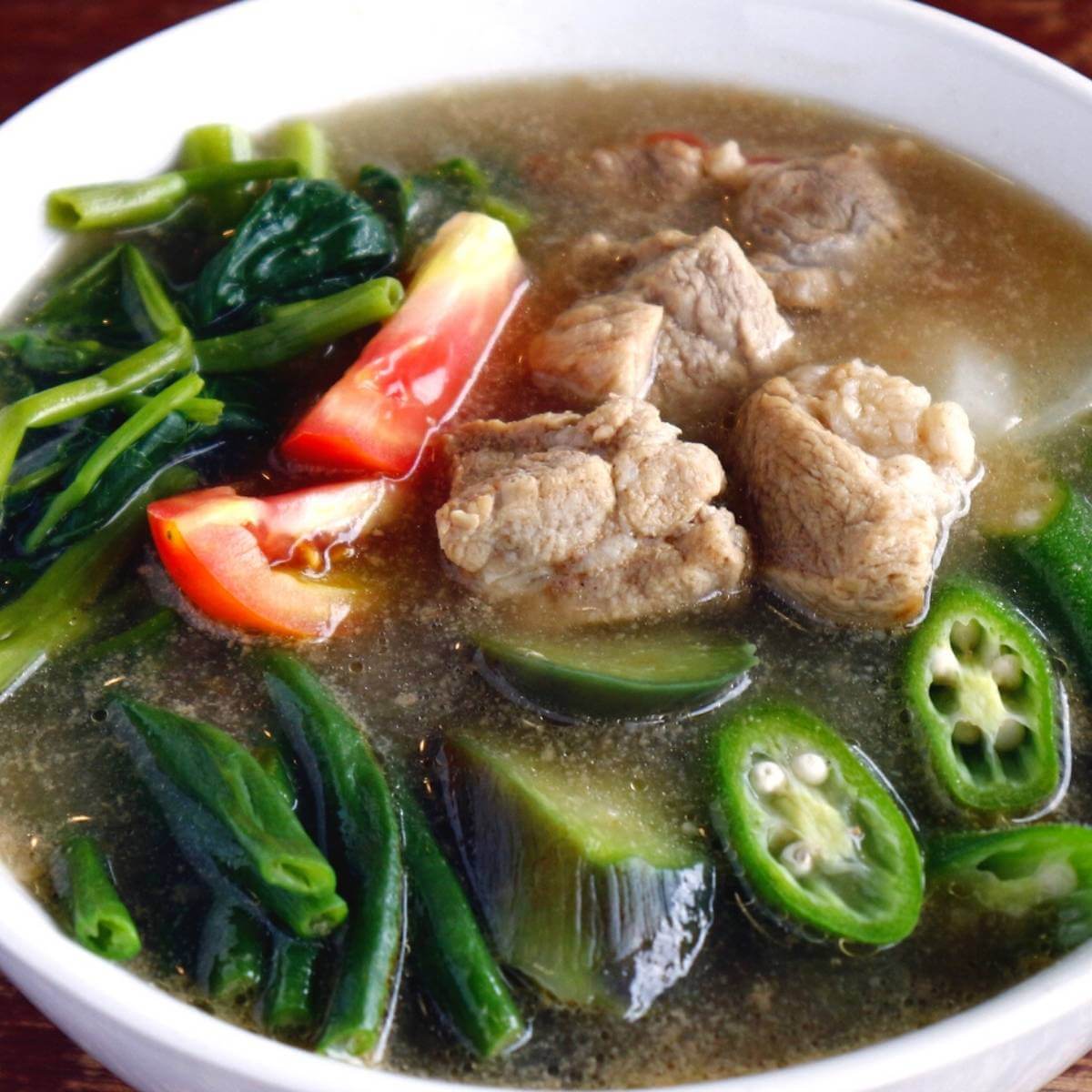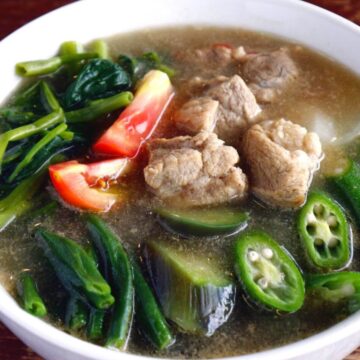Affectionately known as sour pork stew, pork sinigang (sinigang na baboy) is a wonderful Filipino tamarind soup base dish known for its attractive sour and savory flavor. Once you try it, you can't live without it.

Food in the Philippines is always colorful and intensely flavorful, and it’s hard not to find a delicious meal for all occasions. Sinigang, though, is on another level — along with a few other specialties, this meaty and tangy dish is the definition of homey home-cooked meals.
You’ll love pork sinigang. If you want to know what comfort food tastes like in the Philippines, this stew is a great ambassador for the category. And you know what they say, you can’t beat the flavors that remind you of home just like this Filipino adobo recipe.
The question is, what is sinigang? What goes into such an extraordinary dish? Here’s all you wanted to know about pork sinigang. And most importantly, learn how to make it at home!
What Does Pork Sinigang Taste Like?
Sour. Sinigang is not sinigang if it isn't sour.
Before we get started, allow me to tell you why pork sinigang is so special. Stews are universal; every culture has its own warm pots filled with fork-tender meat swimming in a rich broth. Still, not all of them are blessed by tamarind's sweet and tangy flavor, which makes pork sinigang so unique.
Tamarind (sampalok) is an odd-looking leguminous fruit with a hard, brown pod and a particularly acidic pulp. It’s the pulp we’re interested in today. And although tamarind is native to tropical Africa, it’s now grown in warm regions worldwide — it’s particularly cherished in the Philippines!
The flavor of sinigang depends on the protein used. You can use shrimp, chicken, pork, beef, and fish! You can also use the veggies you have in hand. The one ingredient that makes this hearty stew unique is the tamarind, but not any tamarind will do — you need sinigang mix!
Meet the Delicious Sinigang Mix
A proper Sinigang na Baboy, AKA pork sinigang, is flavored with onion, ginger, tomatoes, and perhaps a few chili peppers. The special ingredient, though, is tamarind. And although you can use tamarind pulp to make your stew, in the Philippines, it’s customary to use sinigang mix. So, what is this wonderful condiment?
Recipes vary for different producers but sinigang mix often includes around 7% tamarind, citric acid, sugar, taro, tomato, onion, shrimp, palm oil and spices, so it’s much more than tamarind. Think of a Filipino version of the chicken bouillon — a whole bunch of tasty things dehydrated and used to flavor food!
Sinigang Mix vs Real Tamarind
I won’t lie; sinigang mix can be a bit artificial, although almost no brand uses MSG or artificial flavors today. Still, there’s a question that remains answered. What’s the difference between using sinigang mix and natural tamarind?
For starters, sinigang mix is more than tamarind; it’s a combination of aromatics and spices that give sinigang stews their personality. The tamarind only brings its unique earthy flavor and tartness to the table. Think of sinigang mix as a tamarind soup mix. Sinigang mix has substituted tamarind pulp in most households, and it’s because it’s easier to use, and the results are more reliable and balanced.
Besides, working with tamarind pulp is tedious. You must remove the sticky pulp from the pods and soak it to remove the seeds manually. If you’re feeling adventurous, use natural tamarind pulp on your sinigang soup. Remove the seeds and season the pulp with patis, ground pepper, garlic, and onion powder. Let me know how that goes!
Sinigang Flavorings
Talking about using natural tamarind pulp instead of sinigang mix, know there are many other ways to give the famous Filipino stew flavor and aromatics. Here are some ways to flavor sinigang stews.
- Sinigang mix, of course, is now the standard flavoring for sinigang stews.
- Tamarind pulp is exciting to use and all-natural, although tricky to use.
- Kamias, also known as bilimbi, cucumber tree, or tree sorrel, is a tropical tree with tangy fruit. This unique fruit is an excellent substitute for tamarind. It is widespread in the Philippines, where it plays a role in some sinigang recipes and also in pinangat (stewed fish) and paksiw (food cooked in vinegar).
- Guavas are also sweet, tangy, and lovely substitutes for tamarind; even the guava leaves can add flavor to food.
- Calamansi is a citrus hybrid unique to the Philippines; it’s pretty sour and commonly used in marinades and as a condiment. You can use calamansi juice to give a sour taste to dishes like sinigang.
What Goes Into Sinigang?
Sinigang stews can be as straightforward or as complicated as you want. For starters, you must choose the protein. Pork belly is rich, fatty, and everyone’s favorite, but sinigang stews enriched with shrimp, fish, chicken, or beef are common. Pork ribs are the second most common protein for traditional sinigang.
Then you have the veggies. I love starting my version with red onion and ginger to create a fragrant base. Tomatoes add richness and color to the stew, and a few okra pieces add a snappy bite to every other spoonful.
No doubt, eggplants have a place on every sinigang pot, and white radish is also common. Use water spinach if you can find it; it has a mildly sweet taste and is not nearly as bitter as regular spinach — in fact, they’re not even related!
Feel free to add a few hot peppers to the mix. Banana peppers are not as spicy as jalapeños, but both are common sinigang ingredients.
Finally, you’ll find a few more unusual ingredients that can give personality to your sinigang stew. One of my favorites is dried shrimp or fish, and the other is miso paste — a little goes a long way!
How to Cook Sinigang?
Now, the answer you’ve all been waiting for. How to make such a rich stew? Here’s a summary for making sinigang. You’ll find a detailed recipe below as well.
To make sinigang, you must choose your protein first. If using pork belly or chicken, simmer the meat beforehand to ensure it’s cooked through and tender.
Then you have the stew, starting with some water, preferably meat broth. Throw in your veggies and cook until tender. Keep in mind some take longer to cook than others.
It’s time to add the famous sinigang mix and fish sauce to taste. Taste and adjust. And here’s a tip. If you DO find water spinach, add it at the last minute as it’s pretty delicate.
If you’re making a fish or shrimp version, add the protein at the end as well, as they take just a few minutes to cook.
What Drinks Go with Sinigang?
Since this is a sour dish, drink something sweet or neutral-tasting drink like water. Having said that, some drinks are more compatible with the rich, sour stew, starting with a refreshing cola. Cola’s refreshing sweet taste will cleanse your palate after every spoonful.
Finally, for a local pairing, you might want to try the famous Sago at Gulaman, a Filipino tapioca, and jelly-based refreshing summer drink.
FAQs
For some, pork chops are too tough for a sinigang, so neck bone and pork belly with rib meat are the best alternatives. Make sure you also add some pork bones to flavor the broth. On the other hand, beef flank is a popular cut for sinigang, but oxtail, bone-in short rib, brisket, and round are excellent alternatives. Again, remember that bones add a lot of flavor to the broth. For seafood, shrimp is best for sinigang.
The best side dishes for sinigang are steamy white rice and a salty mixture of fish sauce and chopped chili peppers, which helps accentuate pork’s rich, meaty flavor.
Although not a common alternative in the Philippines, you can make a vegetarian sinigang with your favorite veggies and tamarind soup base. Remember that many sinigang mix brands have some pork, fish, or beef in them, so choose carefully.
Storage
Yes, you can store leftover sinigang. Place leftovers inside an airtight container and consume them within two days. To freeze: You can freeze up sinigang for up to 2 months. I recommend that if cooking in big batches, store sinigang in single-serve containers, then heat one container whenever you feel like eating it without spoiling the rest.
The Recipe
Main Ingredients
- 2 liters water
- Meat
- Vegetables
- Sinigang Mix
- Fish Sauce to taste
Meat variations:
- Pork Belly, pork bones, pork rib
- Beef ribs
- Chicken
- Shrimp
- Fish (Salmon head, Tilapia, etc.)
Vegetables:
- 1 small red onion
- 1 thumb-sized piece of ginger, pressed
- 3 pcs tomatoes
- 6-8 pieces of okra
- 6-8 pcs string beans, sliced into 2-inch pieces
- 2 Eggplants
- 1 medium white radish
- 1 bunch of water spinach (kangkong leaves)
- 2-3 pieces chili pepper (banana pepper, jalapeno) do not slice if you don’t like it spicy.
Optional Ingredients:
- Taro root
- Dried small shrimp (for added umami taste)
- Dried small fish (for added flavor)
- Miso paste
Directions
Note: For pork, beef or chicken, boil the meat first until tender. If using shrimp or fish, add them at the last minute.
- In a pot, boil pork in 2 liters of water. Cook until tender (40 minutes to 1 hour). Remove floating scum on the surface with a spoon or ladle. Add more water if needed.
- Add the onion, ginger, and tomatoes, and boil.
- Add the eggplant, and white radish. Cook until fork tender (5 minutes). Next add the string beans, okra, and chili pepper. Cook until tender (5 minutes).
- Add the sinigang mix and the fish sauce to taste.
- Add water spinach (kangkong) last. (Here you’ll add the shrimp or fish if using them). Let it boil for 2 minutes.
- Enjoy!
Some notes:
Instant sinigang mixes have recipe instructions on the back of the packaging. It's a fail-proof recipe, and I've followed it for years. And just FYI, there are many variants of sinigang mixes. I recommend the original flavor, but you can also try miso or gabi.

Pork Sinigang (Sinigang na Baboy Filipino Recipe)
Ingredients
- 2 litres water
- 1 pound pork spare ribs or pork belly, or any choice of meat and seafood
- 1 small red onion
- 1 tablespoon ginger or a thumb-size, pressed or thinly sliced
- 3 small tomatoes sliced
- 6-8 small okra sliced in 2, crosswise
- 1-2 small eggplants chopped or large diced
- 1 medium white radish chopped or large diced
- 1 bunch water spinach (kangkong) remove stem
- 2-3 pieces whole green chili peppers serrano or jalepeno, slice optional
- 1 pack instant Sinigang Mix (44g pack) original flavor
- 1 tablespoon fish sauce or to taste, optional (you can use salt and pepper to adjust the taste)
Instructions
- In a pot, boil pork in 2 liters of water. Cook until tender (40 minutes to 1 hour). Remove floating scum on the surface with a spoon or ladle. Add more water if needed.
- Add onion, ginger and tomatoes. Let it boil.
- Add the eggplants, and white radish. Cook until fork tender (5 minutes). Next add the string beans, okra, and chili pepper. Cook until tender (5 minutes).
- Add the sinigang mix and the fish sauce to taste.
- Add water spinach (kangkong) last. (Here you’ll add the shrimp or fish if using them). Let it boil for 2 minutes.
- Serve with rice and enjoy!
Notes
- Instant sinigang mixes have recipe instructions on the back of the packaging. It’s a fail-proof recipe.
- There are many variants of sinigang mixes, I recommend the original flavor but you can also try miso or gabi flavor.
- For pork, beef, or chicken, boil the meat first until tender. If using shrimp or fish, add them at the last minute.
- You can make this without the meat to make it vegetarian.





Leave a Comment